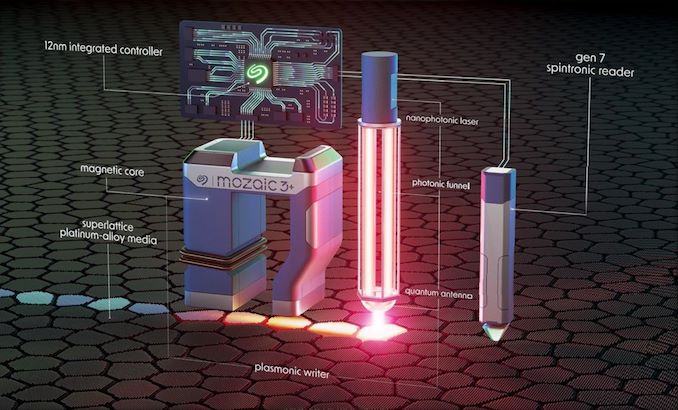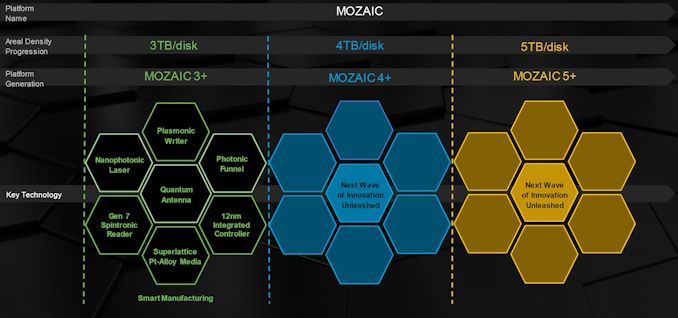Seagate Unveils Mozaic 3+ HDD Platform as HAMR Readies for Volume Ramp
by Ganesh T S on January 17, 2024 6:00 AM EST
Seagate's financial reports have been indicating imminent mass production of HAMR HDDs for a few years now, and it looks like the wait for these drives to appear in retail is finally at an end. The Seagate Exos product family is getting a 30TB capacity point, thanks to the use of heat-assisted magnetic recording (HAMR) technology. The company talked to the press last week about the Mozaic 3+ platform – their first high-volume HAMR platform – and how it sets the stage for rapid areal density scaling over the next few years.
Seagate's new Exos 30TB HDDs use platters with an areal density of 3TB per platter, and Seagate has plans to scale that up at a rate of up to 20% generation-over-generation in the next few years (compared to the 8% rate that CMR HDD capacities have been growing at in the last decade or so). The company indicated that volume shipments are happening this quarter to hyperscalers. Seagate is observing that the average customer upgrading from a 16TB conventional magnetic recording platform to the new 30TB+ HDDs can almost double the capacity of their server racks in the same footprint, as the new drives are drop-in replacements. This brings TCO benefits, particularly in terms of power consumption. The company is even quantifying that - the Exos X16's average power consumption of 9.44W translates to 0.59W / TB. The new Exos 30TB's equivalent number is a bit higher at 10.5W, but that translates to a 40% power savings on a per-TB basis at 0.35W / TB.
The company stressed upon the fact that HAMR needed a host of other breakthroughs grouped under the new Mozaic 3+ tag in order to achieve the areal density breakthrough enabling the new Exos family. These include:
- Platters using new Pt-Fe alloy
- Plasmonic writer
- 7th Gen. spintronic reader
- 12nm integrated controller
Areal density gains are primarily driven by smaller grain sizes in the magnetic media. However, legacy magnetic platter media is not stable at very small grain sizes. Along with Showa-Denko, Seagate has developed a superlattice iron-platinum structure with increased magnetic coercivity to allow for precise and stable data recording. The HAMR process requires heating up of the grain in order to alter its state, and Seagate has achieved this using a nanophotonic laser that is vertically integrated into the plasmonic writer sub-system. The reading head has also needed to evolve in order to tap into the smaller grains. All of these advancements work together thanks to a newly developed controller (built on TSMC's 12nm process) that Seagate claims to deliver 3x the performance of existing solutions.
Seagate expects the Mozaic platform to lead to 5TB/platter as early as 2028.
Areal density scaling is one of the key aspects in addressing the HDD capacity issue. One aspect that this scaling has not addressed is the IOPS/TB metric, where SSDs are in a much better place to take advantage of advancements in host interface technology. The Mozaic platform is orthogonal to currently-used HDD technologies such as dual actuators and shingled-magnetic recording. Additional benefits can be gleaned from those, but the IOPS/TB metric scaling is an aspect that needs industry-wide efforts to address to keep HDDs relevant in more application areas.
Seagate works with vendors such as Showa-Denko for the platters and TDK for the recording heads. Some of the Mozaic 3+ innovations have been jointly developed with them. While the exact details of the joint development are confidential, Seagate indicated that they have a time-limited exclusive use for these technological advancements. If, and when, other HDD vendors move to HAMR, it appears that Seagate has a healthy lead to fall back on with respect to these core HAMR platform components. The company is also expecting the Mozaic 3+ technology to address use-cases as as NAS, and video / imaging markets. It is only a matter of time before HAMR moves from Exos to the IronWolf and SkyHawk families.













29 Comments
View All Comments
Hamm Burger - Wednesday, January 17, 2024 - link
Well, the article at least attains a new record in areal density of buzzwords.abufrejoval - Wednesday, January 17, 2024 - link
Thanks a lot for that laugh!Threska - Wednesday, January 17, 2024 - link
Mechatronics go brrrr.Watcherrr - Wednesday, January 17, 2024 - link
In my personal scenarios, I have two problems with these 10+ TBs HDDs. One is when one drive fails it takes 30+ hrs for plain data copy/recovery. Not sure if these can always withstand full speed copy for 30+ hrs straight. Many times the source/backup HDD will fail during the copy. I know this is not an issue for data centers, but might be for power user at home. But also rebuild in data center can take significantly more time compare to 5-6 TB drives.The second problem is the speed. While capacity increased 3x from 10TB to 30TB, the speed increased 2x from 250 MB/s to 550 MB/s for MACH.2 drives. The speed cannot keep the pace with the capacity. Again, may not be that big of a problem for data centers, but home/power users may be put off by this.
charlesg - Wednesday, January 17, 2024 - link
Home user here. I have a bunch of 16tb drives that I use in my unraid array. I made sure I bought them from different places and are different models, so if I have to do a rebuild, it's unlikely other drives are in the same 'ready to fail' mode.That said, I have an offline array as a backup. Your concerns are legit..
Samus - Wednesday, January 17, 2024 - link
It is deeply concerning that hard disks have increased in capacity by orders of magnitude for decades but have effectively stalled in transfer rate, which, as you said, makes rebuilding a single disk extremely time consuming, not to mention the time and cost associated with migrating from old disks to new ones.But the laws of physics cannot be broken. While aerial density and controller performance increases have minute benefits to throughput, the footprint, rotation speed and physical limitations of the actuator and head prevent any real gains. WD has tried to address this with dual actuators, but according to blocks and files, that doesn't actually scale out to double the throughput because of obvious overhead. But it's close, and double is at least something :)
The Von Matrices - Wednesday, January 17, 2024 - link
Disks getting slower relative to their capacity is unfortunately just a result of math. Data density increases in three dimensions (angular density, radial density, z (number of platters)) while disk transfer rate only increases proportionally to the density increase in the angular dimension.As a result, transfer rate only increases by sqrt(2) each time the density increases by a factor of 2, and it gets worse if more platters are added to a drive because they increase capacity without increasing platter density.
Assuming you can currently read at ~250MB/s on a 16TB drive, you need 17.8 hours to read the entire disk. If transfer rate scales exactly with density, a 30TB drive will read at 342 MB/s and will take 24.3 hours to the entire disk. If Seagate reaches its target of 48TB disks, then they will read at 433 MB/s and take 30.8 hours to read the entire disk.
Even doubling the number of actuators to double the transfer rate just brings disk write time back to where it was a few years prior, and increasing the spindle speed is a non-starter. I'm not sure if there is any way to deal with this slowdown other than software workarounds.
ballsystemlord - Wednesday, January 17, 2024 - link
So let's make all the actuators separate from each other.On top of that you could also create a new size for HDDs so that you could fit actuators on 4 sides of the drive. Changing form factors has been done before. Take, for example EATX. And to this day that still isn't a standardized ATX size AFAIK.
GeoffreyA - Thursday, January 18, 2024 - link
SSDs were supposed to solve the problem :)But yes, with the classic hard disk design of mechanical motion to read a certain point, there isn't going to be much of a change.
FunBunny2 - Thursday, January 18, 2024 - link
"So let's make all the actuators separate from each other."back in the goode olde days, mainframes and some minis had drives with multiple radial actuators. back then, transfer rates were pitiful by today's standards, due mostly to large grains and slow rotation, so having multiples was mostly a requirement. it's just a guess, but having radial actuators should improve performance over the swingers?